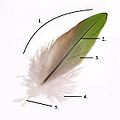Feather
Feathers are the things which cover birds. They help keep birds warm. Feathers also protect them from injury. In most kinds of birds, wing feathers help them to fly. These are called flight feathers. Some people have their pet birds clipped. This is a procedure where a vet or a groomer cuts a certain amount of feathers to prevent the bird from flying away or simply for medical reasons. [1]
Vaned feathers
The main feathers which cover the outside of a bird are called vaned feathers. Vaned feathers have a stiff center, with soft barbs on the side, which seem like hairs. The center is called a quill. This type of feather is called pennaceous (= like a pen).
Down feathers
Young birds have small feathers, called down, which keep them warm, but cannot be used for flying. Down is very soft. Adult birds have down, but also have vaned feathers on top of the down. Down is also used in blankets. Down feathers are just one example of plumaceous feathers (the word means 'fluffy'). Another example is the feathers on flightless birds such as the ostrich.
Moulting
Birds lose their feathers at certain times. This is called moulting. By moulting, a bird can replace old feathers with new ones. Many birds moult once every year.
Color
Feathers give birds color. The function of color in birds is extremely important. It includes:
- Camouflage: it hides the bird in its natural environment, especially when it is stationary in the nest. Camouflage is often backed up with behaviour: see the bittern on its nest.
- Display: birds carry display colors when they need to be noticed by other birds. Often the male of a pair will do the display and wear colors, while the female is camouflaged. Display is usually backed up by behaviour, especially bird song. The main functions are:
- To attract a mate
- To signal and defend their territory.
Use by people
People use feathers for many purposes. In the past, quills were commonly used as pens, and colorful feathers were worn on hats. Many pillows, cushions, mattresses, coats, and quilts are stuffed with down. Feathers are also used by people of many tribes for decoration.[2]
Feather Media
Anterior region of a contour feather from a rock dove, visualized using scanning electron microscopy. Interlocking barbules are clearly seen in the middle image.
Filoplumes can be important in nuptial display; in the great cormorant they are white, and produced on the head and upper neck at the start of the breeding season, and shed soon after nesting.
Feather structure of a blue-and-yellow macaw
A contour feather from a Guinea fowl
Rictal bristles of a white-cheeked barbet
Colors resulting from different feather pigmentsLeft: turacin (red) and turacoverdin (green, with some structural blue iridescence at lower end) on the wing of Tauraco bannermaniRight: carotenoids (red) and melanins (dark) on belly/wings of Ramphocelus bresilius
References
- ↑ Prum, Richard O. & Brush A.H. 2002. The evolutionary origin and diversification of feathers. The Quarterly Review of Biology. 77 (3): 261–295. doi:10.1086/341993
- ↑ McLelland J. 1991. A color atlas of avian anatomy. W.B. Saunders. ISBN 0-7216-3536-9
| Wikimedia Commons has media related to Lua error in Module:Commons_link at line 62: attempt to index field 'wikibase' (a nil value).. |













